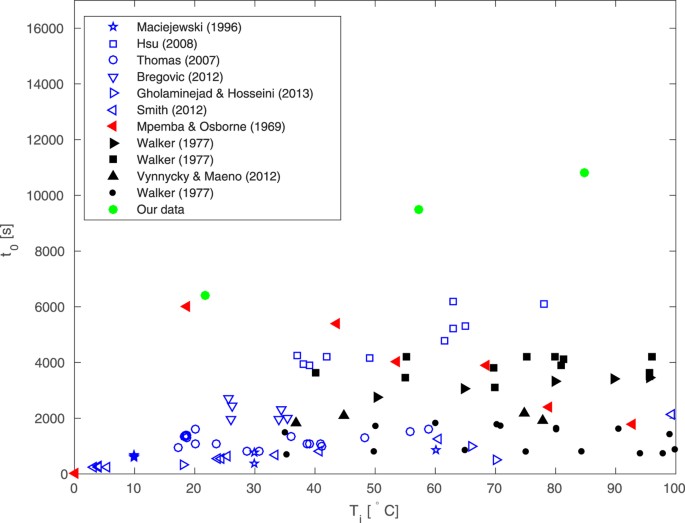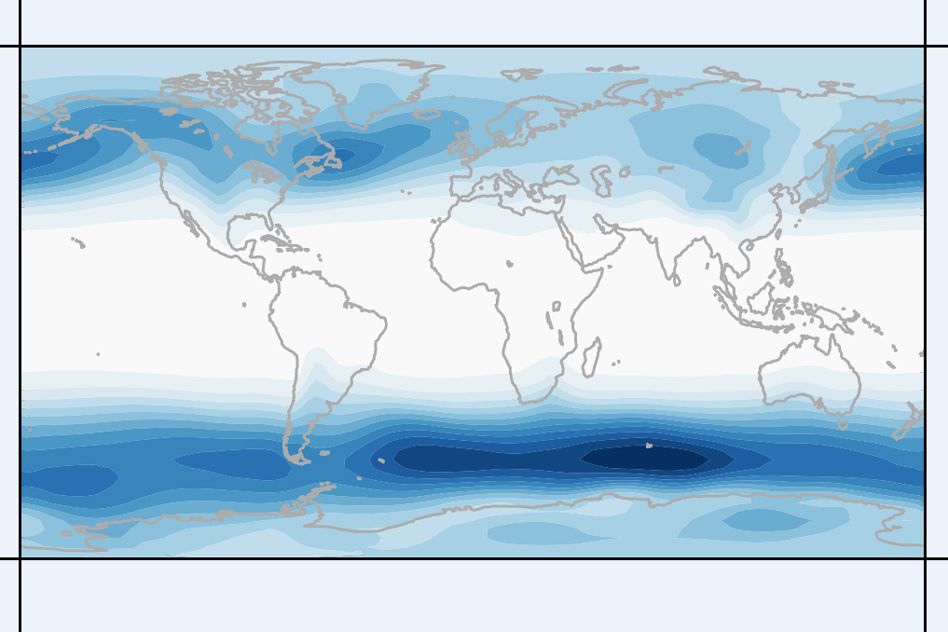Explore web search results related to this domain and discover relevant information.
A model exhibiting a hysteresis in the cooling of water is presented by ref. 5 which is compared to an observation of the Mpemba effect documented as part of a popular science competition organised by the RSC7 — we include the experimental observations by ref. 7 within the data analysed in the present study...
However, other studies report being able to reproduce the effect, typically, using domestic style ice formation. Numerous differences exist between the experimental conditions of these various studies. These variations include: altering the nature of the cooling supplied, e.g.A number of studies have proposed physical models for the freezing of water in connection with the Mpemba effect. Katz26 developed a freezing front model based on a ‘Stefan problem’ with a moving boundary condition which is unable to predict the effect, while the models of Kell18, Vynnycky and co-workers27,28 consider the effects of evaporative cooling, suggesting that evaporation alone is sufficient to observe the Mpemba effect.Figure 1 plots the variation in the time t0, to cool samples to 0 °C, with the initial temperature from a variety of studies including our ‘Mpemba-type’ experiments. We have attempted to represent a broad selection of published experimental data regarding the Mpemba effect.Figure 2 shows the variation in the cooling time t0, scaled by the convective time scale, with the temperature averaged Rayleigh number from the various studies detailed in Fig. 1 (for details of the convective time scale and the temperature averaged Rayleigh number see the Methods section).

32K Followers, 1,243 Following, 574 Posts - See Instagram photos and videos from 💗Cool Studies💗 (@cool_studies)
32K Followers, 1,243 Following, 574 Posts - 💗Cool Studies💗 (@cool_studies) on Instagram: "👩🏻🏫 2° EM - 🇧🇷 📒 #estudos #studygram 🤍 Duda, Nicole e Yasmin 📚 Dicas de estudos, resumos, lettering"


After studying nearly 6,000 people, researchers discovered that "cool" people share remarkably similar traits worldwide.
Coolness and goodness aren’t the same: while good people tend to be warm, agreeable, and traditional, cool people stand out for being daring, independent, and willing to break from convention. The study suggests coolness serves an important social role worldwide, signaling traits that help individuals influence others, drive innovation, and challenge the status quo regardless of culture.SANTIAGO, Chile — What makes someone genuinely cool? After studying nearly 6,000 people across 13 countries spanning six continents, researchers discovered that “cool” people share remarkably similar traits worldwide from San Francisco to Seoul, Sydney to Santiago.The international study, published in the Journal of Experimental Psychology: General, reveals that whether you’re in Germany, Nigeria, Turkey, or Australia, cool people are consistently seen as more extraverted, powerful, hedonistic, adventurous, open to new experiences, and autonomous.Cool people command respect, influence social trends, and often enjoy higher status in their communities. Studies show that being perceived as cool affects everything from how likable and attractive someone appears to their access to resources and social inclusion.

From Chile to China, cultures vary greatly around the globe, but people in at least a dozen countries agree about what it means to be cool, according to research published by the American Psychological ...
Apart from any fair dealing for the purpose of private study or research, no part may be reproduced without the written permission. The content is provided for information purposes only. Explore further Japan's Nissan is developing 'cool paint' for cars to keep drivers coolerOnly participants who were familiar with the slang meaning of the word "cool" were included in the study."Everyone wants to be cool, or at least avoid the stigma of being uncool, and society needs cool people because they challenge norms, inspire change, and advance culture," said co-lead researcher Todd Pezzuti, Ph.D., an associate professor of marketing at the Universidad Adolfo Ibáñez in Chile. The research was published online in the Journal of Experimental Psychology: General. The study included experiments from 2018 to 2022 in the United States, Australia, Chile, China (mainland and Hong Kong), Germany, India, Mexico, Nigeria, Spain, South Africa, South Korea and Turkey.Citation: Cool is cool wherever you are: Study finds cross-cultural agreement (2025, June 30) retrieved 17 July 2025 from https://phys.org/news/2025-06-cool-cultural-agreement.html

La idea de ser “cool” puede parecer esquivo para los crónicamente poco cool. Un nuevo estudio internacional muestra seis formas en que puede dejar atrás esa falta de frío para siempre.
Podrá parecer muy de los 70's el término “cool” pero nunca parece pasar de moda como atributo deseable. Si tienes niños o trabajas con ellos, es probable que todavía los escuches poner a sus amigos en los dos grupos distintos de lo cool versus lo poco cool.Debido a que lo cool conlleva muchas asociaciones positivas, podría confundirse fácilmente con “bueno”, argumentan los autores. Sin embargo, debido a que ambos términos se usan de maneras ligeramente diferentes, debe haber algo que los diferencie. Parte de la inspiración para el estudio de Pezzuti et al.Esta escala de valores capturó lo que los autores creían que podrían ser cualidades cool importantes versus no cool, incluida la autonomía, la aventura, el hedonismo, la conformidad, el poder, la calidez, la tolerancia, la capacidad, la preferencia por la seguridad y el enfoque en la tradición.Debido a que la relación cool-bueno refleja tanto una cuestión de grado como una distinción clara, los autores tuvieron cuidado de presentar sus hallazgos en términos relativos. En algunos casos, las distinciones fueron solo leves, pero entre estos seis finalistas surgió un patrón claro.
This site requires JavaScript to be enabled

Try as you might, you may feel that you’ll never be one of the “cool kids” in your social group. A new study reveals the six key features that people around the world use to define what’s cool.
Because cool carries with it many positive associations, it could easily be mistaken for “good," argue the authors. However, because both terms are used in slightly different ways, there must be something that differentiates them. Part of the inspiration for the Pezzuti et al. study was to separate these two related qualities.It’s impressive that there was so much agreement across cultures, leading the authors to propose what they call “a theory of coolness.” More than just a product of commercial enterprises trying to sell you the latest product, this theory argues that coolness could serve the social function of a status hierarchy “that promotes creativity and innovation.” Yes, having money is implied in the value of being powerful, but this could be the result of cool people making money as a result of their ability to acquire wealth through gaining status in the social hierarchy. What's more, power waA study of individuals with borderline personality found that 94% reported psychosis-type experiences.As '70s-ish as the term seems to be, “cool” never seems to go out of style as a desirable attribute. If you have kids or work with them, you’ll likely still hear them put their friends into the two distinct groups of the cool versus the uncool. You might be drawn to one pair of sneakers vs.

The study is based on psychology experiments conducted from 2018 to 2022 with about 6,000 adult participants from the US, Australia, Chile, China, Hong Kong, Germany, India, Mexico, Nigeria, Spain, South Africa, South Korea, and Turkey. Each participant was asked to think of someone they thought was “cool...
The study is based on psychology experiments conducted from 2018 to 2022 with about 6,000 adult participants from the US, Australia, Chile, China, Hong Kong, Germany, India, Mexico, Nigeria, Spain, South Africa, South Korea, and Turkey. Each participant was asked to think of someone they thought was “cool”, “not cool”, “good”, or “not good”, and then rate that person’s personality and values.Using this data, researchers assessed how cool people differed from “uncool” and “good” people. “Everyone wants to be cool, or at least avoid the stigma of being uncool, and society needs cool people because they challenge norms, inspire change, and advance culture,” study co-lead researcher Todd Pezzuti explained.The growth of fashion, music and film industries globally has seen the meaning of cool “crystallise on a similar set of values and traits around the globe”, becoming “more commercially friendly”, the study noted.People deemed “cool” boast six surprisingly similar personality traits across cultures, according to a new study that hints at the role played by broadcast media in standardising the meaning of the term.

In a global study over four years, researchers discovered that people who are seen as cool share similar traits in countries around the world.
Cool is universal in more ways than you might expect. For example, the study found that even in countries with languages based on non-Latin alphabets, such as South Korea and Turkey, “people use the word cool, often pronouncing it similarly to how it is pronounced in English.”For example, a hedonistic person who parties all night, abuses drugs, and has reckless sex will likely strike most people as being irresponsible rather than cool.” · Good people, the study found, have many of those same qualities, but other personality traits were ranked more highly by the subjects.“Everyone wants to be cool, or at least avoid the stigma of being uncool, and society needs cool people because they challenge norms, inspire change, and advance culture,” said co-lead researcher Todd Pezzuti, PhD, an associate professor of marketing at the Universidad Adolfo Ibáñez in Chile, in a statement. The peer-reviewed study, which was published in the American Psychological Association’s Journal of Experimental Psychology, included experiments with roughly 6,000 participants from around the world between 2018 and 2022.“The concept of coolness started in small, rebellious subcultures, including among Black jazz musicians in the 1940s and the beatniks in the 1950s. As society moves faster and puts more value on creativity and change, cool people are more essential than ever.” · The study found that being cool largely comes down to six traits.
We examine whether conservative white males are more likely than are other adults in the U.S. general public to endorse climate change denial. We draw…
Such studies have analyzed the direct effects of political ideology, race, and gender, typically finding that self-identified liberals2 (Hamilton, 2008, McCright, 2010, Wood and Vedlitz, 2007), non-whites (Malka et al., 2009, McCright, 2010, McCright and Dunlap, 2011, Wood and Vedlitz, 2007), and females (Brody et al., 2008, Hamilton, 2008, Leiserowitz, 2006, Malka et al., 2009, McCright, 2010, McCright and Dunlap, 2011, O’Connor et al., 1999) are more likely to express concern about global warming than are their conservative, white, and male counterparts, respectively.In the process, we extend recent climate change public opinion studies, especially those focusing on the impacts of political orientation (e.g., Dunlap and McCright, 2008, Hamilton, 2008, Hamilton, 2011, Hamilton and Keim, 2009, Malka et al., 2009, McCright and Dunlap, 2011) and gender differences (e.g., Brody et al., 2008, Hamilton, 2008, McCright, 2010).


An international team of researchers may have just cracked the code for what makes someone “cool.”
Regina George, Jay Gatsby and Olivia Pope are among the powerful, extroverted characters who check the "cool" boxes. But, the researchers behind the new study note, that isn't always the same thing as "good."And no matter where you live, the personality traits that make someone “cool” appear to be consistent across countries, according to the study, published this week in the Journal of Experimental Psychology.The researchers found that, compared with people considered to be “good” or “favorable,” those considered “cool” are perceived to be more extroverted, hedonistic, powerful, adventurous, open and autonomous. “The most surprising thing was seeing that the same attributes emerge in every country,” said Todd Pezzuti, an associate professor of marketing at Universidad Adolfo Ibáñez in Chile who was a co-lead researcher on the study.The participants were asked to think of a person in their lives whom they perceive to be “cool,” “uncool,” “good” or “not good.” They were then asked to rate that person’s personality using two scales: the Big Five Personality scale, a widely used scientific model that helps describe personality traits, and the Portrait Values Questionnaire, intended to measure an individual’s basic values. The study participants consistently associated being calm, conscientious, universalistic, agreeable, warm, secure, traditional and conforming with being a good person, more than with being a cool person.
New Berkeley Lab study finds that in reducing air temperatures, cool roofs could protect urbanites from heat waves
A new study by researchers at the Department of Energy’s Lawrence Berkeley National Laboratory (Berkeley Lab) shows that if every building in California sported “cool” roofs by 2050, these roofs would help contribute to protecting urbanites from the consequences of these dangerous heatwaves.Their study, “Interacting implications of climate change, population dynamics, and urban heat mitigation for future exposure to heat extremes,” was recently published in the journal Environmental Research Letters. The researchers predict that heat waves are likely to become two to 10 times more frequent across the state by mid-century. But if cool roofs were adopted throughout California’s most populous areas – the San Francisco Bay Area, Los Angeles, San Diego, and Sacramento – by 2050 these reflective roofs could bring down heat wave exposures (defined as each time a person experiences a heat wave) by 35 million each year, compared to an estimated 80 million heat wave cases in 2050 with no increase in cool roof adoption.When nighttime temperatures remain elevated, human bodies struggle to cool down and recover from the day’s scorching heat. In summer, when urban heat island effects peak, human health can be severely compromised. Add a heat wave to this already heat-stressed environment, and impacts exacerbate. In this study, a heat wave consists of at least three consecutive days with maximum air temperature of 35 C or higher.The simulation above illustrates the extent to which cool roofs could reduce annual population exposure to heat waves in Northern and Southern California in mid-century under hot and warm scenarios, driven by high greenhouse gas emissions and more modest emissions, respectively. (Credit: Berkeley Lab) In this new study, the Berkeley Lab researchers had two goals.

In the journal article, the research is described as the first systematic, quantitative examination of what characteristics recur in popular understandings of the cool personality. The researchers conducted three separate studies. In Study 1, participants generated characteristics that they ...
In the journal article, the research is described as the first systematic, quantitative examination of what characteristics recur in popular understandings of the cool personality. The researchers conducted three separate studies. In Study 1, participants generated characteristics that they perceived to be cool.How can you combine the idea of cool—emotionally controlled and distant—with passionate?” · At some levels, participants in the study still appreciated the traditional elements of cool, such as rebelliousness and detachment, but not as strongly as friendliness and warmth.Dar-Nimrod’s main research interests are the effects of genetics and social environment on decision-making and health behaviors. The coolness research began when Dar-Nimrod was a doctoral student at the University of British Columbia. He and a fellow student, Ian G.In Study 2, two samples of participants rated dozens of these characteristics on two dimensions: coolness and social desirability.

This is FRONTLINE's old website. The content here may be outdated or no longer functioning · FRONTLINE reports from Iraq on the miscalculations and mistakes behind the brutal rise of ISIS

Researched surveyed nearly 6,000 people in 13 different countries about what makes a person cool, and found the answers to be surprisingly universal.
Cool is cool, no matter where you are in the world. That's the conclusion of a new study that surveyed nearly 6,000 people in 13 different countries about what makes a person cool, and found the answers to be surprisingly universal.Despite cool's distinctly American origins, Dinerstein wasn't at all surprised by the study's conclusion that cool is a universal concept."In our survey, we asked people about the word cool without trying to translate it," he said. "And so both the word and meaning have spread around the world, with the meaning largely intact." ... The study's authors say that over the years, coolness has strayed from its counterculture origins and morphed into something "more mainstream" and "commercially friendly," with major brands like Pepsi and Nike turning it into a commodity.As It HappensWhat is the essence of cool? Study narrows it down to 6 key traits
Reflecting sunlight to cool the planet will likely cause other global changes in climate: An MIT study has found that solar geoengineering proposals will weaken extratropical storm tracks in Northern and Southern hemispheres.
Study of 3.5 million cells from more than 100 human brains finds Alzheimer’s progression — and resilience to disease — depends on preserving epigenomic stability. ... Super-cooling radioactive atoms could produce a laser-like neutrino beam, offering a new way to study these ghostly particles — and possibly a new form of communication.Popular Mechanics reporter Caroline Delbert writes that a study by MIT researchers finds that solar geoengineering efforts aimed at cooling the planet would change extratropical storm tracks.After all, volcanoes do essentially the same thing, albeit in short, dramatic bursts: When a Vesuvius erupts, it blasts fine ash into the atmosphere, where the particles can linger as a kind of cloud cover, reflecting solar radiation back into space and temporarily cooling the planet.On the one hand, spraying aerosols into the stratosphere would reduce incoming solar heat and, to a degree, counteract the warming caused by carbon dioxide emissions. On the other hand, such cooling of the planet would not prevent other greenhouse gas-induced effects such as regional reductions in rainfall and ocean acidification.


Coolness has changed. Today it’s about being extroverted, hedonistic, adventurous, open, powerful and autonomous.
But what exactly makes someone cool? Is it just about being popular or trendy? Or is there something deeper going on? ... In a recent study I conducted with other marketing professors, we set out to answer a simple but surprisingly unexplored question.Some “cool” traits were not necessarily good at all, like extroversion and hedonism. ... One of the most fascinating aspects of our study was seeing how consistent the meaning of coolness was across cultures – even in countries with very different traditions and values.We asked nearly 6,000 people from 12 countries to think of someone they personally knew who was “cool”, “not cool”, “good”, or “not good”. Then we asked them to describe that person’s traits and values using validated psychological measures.Some of these scholars trace this form of cool to slavery and segregation, where emotional restraint was a survival strategy among enslaved Africans and their descendants, symbolising autonomy and dignity in the face of oppression.

Six traits can determine your ‘it’ factor, according to researchers who measured coolness around the globe.
Is there a secret sauce that helps explain why people as different as David Bowie, Samuel L. Jackson and Charli XCX all seem so self-assured and, well, cool? A new study suggests that there are six specific traits that these people tend to have in common: Cool people are largely perceived to be extroverted, hedonistic, powerful, adventurous, open and autonomous.The study, which was published on Monday in the Journal of Experimental Psychology: General, surveyed nearly 6,000 participants from 12 countries around the world. Their beliefs about what’s “cool” were similar regardless of where the study participants lived, and despite differences in age, income level, education or gender.In the study, each participant had to recognize the word “cool” in English, without translation, suggesting that they were already familiar with — or maybe even idolized — notions of coolness from wealthy Western countries like the United States.In that sense, the study offers a window into the spread of cultural beliefs from one group of people to another, said Joseph Henrich, an anthropologist and a professor of human evolutionary biology at Harvard who was not involved in the study. “Globally, American success has led to the diffusion of music styles and an immense amount of cultural content, including, apparently, the concept of cool,” Dr.
Background and purpose: Hypothermia is effective in improving outcome in experimental models of brain infarction. We studied the feasibility and safety of hypothermia in patients with acute ischemic stroke treated with thrombolysis.
Conclusion: Induced hypothermia appears feasible and safe in patients with acute ischemic stroke even after thrombolysis. Refinements of the cooling process, optimal target temperature, duration of therapy, and, most important, clinical efficacy, require further study.Background and purpose: Hypothermia is effective in improving outcome in experimental models of brain infarction. We studied the feasibility and safety of hypothermia in patients with acute ischemic stroke treated with thrombolysis.Methods: An open study design was used. All patients presented with major ischemic stroke (National Institutes of Health Stroke Scale [NIHSS] score >15) within 6 hours of onset. After informed consent, patients with a persistent NIHSS score of >8 were treated with hypothermia to 32+/-1 degrees C for 12 to 72 hours depending on vessel patency.Feasibility of hypothermia beyond 3 weeks in severe ischemic stroke: an open pilot study using γ-hydroxybutyrate.

The study stated that 42.2% of Generation Z respondents used its social network Google Plus, putting it ahead of Twitter (35.4%) and Pinterest (26.6%) and only a little over 10% behind Facebook.
Well kids, the bond market doesn't think you're cool either pic.twitter.com/667VlxxK7K— Mike Bird (@Birdyword) April 3, 2017 · But those surveyed for the Google study were united in their appreciation of Google, with Millennials describing it as “serious and functional” and Generation Z finding it more “fun and functional”.But the finding betrays the fact that a Google Plus account comes part and parcel with use of its other services such as Gmail. An independent study in 2015 suggested fewer than 1% of Google’s 2.2bn users were active on Google Plus.The study stated that 42.2% of Generation Z respondents used its social network Google Plus, putting it ahead of Twitter (35.4%) and Pinterest (26.6%) and only a little over 10% behind Facebook.Today’s teenagers think Google and Google brands are cool, research funded by Google has found.







